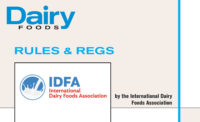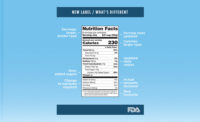
Assurance Policy
by Lynn Petrak
Programs to ensure quality encompass increasingly
high-tech tools.
When it comes to sending
dairy products out the door and ultimately into the mouths of consumers, it
takes more than just some faith and finger crossing that the items are the
best possible quality. Any number of defects — harmful microbes,
shards of metal or incorrect chemical composition — can mean the
difference between satisfied, returning customers and losses or lawsuits.
A standard dictionary may not have a working
definition of the term, but in most manufacturing circles, quality
assurance means certain steps are taken to ensure a company’s goods
or services are of sufficiently high quality. Those concrete actions, which
involve extensive planning and a fair investment in various tools and
techniques, are standard business practice today.
In the dairy industry, quality assurance is taken
seriously by global dairy corporations and small processors alike.
There are dozens of validation, tracking and testing
tools designed for dairy products, including tests for physical, chemical
and microbiological contents. Quality-assurance programs can fall under
various umbrellas within an operation and are considered part of many
people’s responsibilities.
Over the past several years, dairy processors have
demonstrated a willingness to go to great lengths to ensure product
integrity, consistency and safety through formal quality-assurance
programs. Suppliers of diagnostic equipment and services have noted the
increased interest. “Before, it was really a sales job to convince
them they needed it. Now that it has become more the norm, people are
realizing the value proposition and that it is really a way of protecting
your brand,” says Viggo Nielsen, president of Tampa, Fla.-based
Safeline Metal Detection.
Quality-assurance specialists underscore the fact that
dairy processors have focused on this issue, even as they face a host of
other demands. “The dairy industry must strike a difficult balance
between fulfilling HACCP (hazard analysis critical control point) and
regulatory compliance, assuring product quality and nutritional integrity
and consumer expectations, and meeting fiscal and budgetary
requirements,” says Gerard Ruth, vice president of sales for
Lawrence, Mass.-based Charm Sciences Inc., which offers a broad range of
diagnostic tests for antibiotics, aflatoxins, somatic cells, and
pasteurization and hygiene validation.
Others agree dairy manufacturers are distinctive in
how — and by how many — their products are controlled.
“Compared to most other food industries, the dairy industry is
heavily regulated by city, state and federal agencies,” says Ken
Micciche, director of marketing for Advanced Instruments Inc., Norwood,
Mass., a comprehensive diagnostic testing supplier.
Adds Steven Nason, who works in business development
for hygiene monitoring and microbiological testing company Hygiena in
Camarillo, Calif.: “Dairy operators have to comply with federal and
state legislation as well as industry codes of practice that recommend good
manufacturing practices, sanitation SOP (standard operating procedures) and
HACCP.”
Meanwhile, change has also come from within, as
dairies continue the acquisitions and mergers trend and as product lines
become more diverse. “With consolidation going on in the dairy
industry, more big companies own more of the processing plants. The need
for them to get data from their plants to a centralized location is
critical to be able to report on quality,” says Scott Scdoris,
manager of national dairy business for Chicago-based Celsis International
plc, which supplies rapid-diagnostic products and laboratory services.
Micciche agrees that quality-assurance programs are
often retooled as consolidations change the landscape. “As the
industry has consolidated, the companies have typically become larger and
as a result have established quality programs and protocols. They seem to
standardize on equipment once they have proven its value to their
operations,” he says.
QA on the QT
For dairy products, quality assurance begins right
with the cow. Hygiena, for instance, offers SpotCheck Plus hygiene tests
for use by producers on the farm. Likewise, Charm Sciences offers tools for
several points along the food chain. “Our customer base starts with
the farmer, the farmstead operation and the pump over stations,” Ruth
says, “and ends with the manufacturing plants that receive raw milk
and further process, or receive fractionated dairy products and ingredients
and further process.”
Within a dairy-processing environment,
quality-assurance tools are used to gauge a product’s physical,
chemical and microbiological characteristics. On the physical side, there
are many measures that can help processors ensure quality and consistency.
Scales and checkweighers, for example, are
increasingly sophisticated as quality-assurance programs continue to
expand. To complement its existing line of electronic balances, digital
scales, weighing indictors and viscometers, Milpitas, Calif.-based A&D
Weighing recently introduced a new Ninja® Digital Scale line, a
lightweight, low-profile design featuring the latest in calibration
function, multiple weighing units, and a large LCD display, among other
attributes. Also this spring, A&D unveiled a new line of Bluetooth®
balances, scales and indicators that allow users to eliminate the cables
required when communicating weighing to nearby computers.
Another component of physical testing tied to quality
assurance is the detection of foreign objects. Safeline offers several
tools for solid contaminant detection, including metal detectors and X-ray
equipment. “We are seeing a trend for dairy companies to have metal
detectors on all lines, except for fluid,” Nielsen reports, adding
that the move has come in part due to demands from retail and foodservice
customers. More X-ray machines have been added as well, he says, to detect
non-metal objects like glass or even PVC plastic pieces.
As far as improvements go, changes in metal detection
and X-ray technology have focused on enhanced sensitivity as well as
reliability, according to Nielsen. “We are spending significant time
and effort to make sure the metal detectors we supply have a 100 percent
up-time. It is not acceptable that a metal detector can shut down a $2
million production line,” he explains, adding that X-ray technology
has also become easier to use for plant operators. “In the past,
customers had to receive significant training in this technology, but today
the system software is much more intuitive and easier to run and
operate.”
In addition to physical testing, chemical and
microbiological assessments that include instruments and services for both
sanitation and validation purposes are core to many quality assurance
programs. Again, there are a variety of methods and accompanying tools that
can be used in a dairy plant.
Such systems have a range of applications, from
checking raw materials to evaluating work surfaces to monitoring support
systems. Hygiena, for instance, offers a Pi 102 luminometer used for
biomass detection in water supplies.
Pasteurization verification is another major step in
quality assurance. Charm Sciences offers a PasLite test for
pasteurization verification. “PasLite’s sensitivity advantage
provides an early warning indicator of potential problems, like leaky
gaskets or cross connections, tiny cracks or pinholes in stainless steel
plates, when deviations beyond critical limits occur,” Ruth says.
“This is in keeping with the HACCP premise that it is far less costly
to anticipate and prevent quality problems than to react after problems
appear.”
Because the detection of harmful pathogens is critical
to safety, detection measures are built in to many quality assurance
systems. For its part, Celsis supplies Adenosine TriPhosphate (ATP)
bioluminescence-based testing to find the absence/presence of
microorganisms. Last year, the company introduced a new Innovate
system to detect microbial contamination in ultra heat treated (UHT) and
extended shelf life products. “It is a completely new software and
reagent system for us,” Scdoris says, adding that the exceptionally
fast system has great potential in the dairy sector. “The dairy
industry does a huge amount of testing compared to other industries and has
a great amount of data.”
In addition to speed and accuracy, Scdoris says
customers are looking for integrated databases. “With changes in the
food industry, as far as being mandated to provide instant traceability,
this system makes it very easy to pull up results from
micro-testing,” he says. According to Scdoris, a user can export
information from the database into a format that can be immediately emailed
to someone within the organization.
Another company that has improved microbiological
tools is Chaska, Minn.-based Bentley Instruments Inc., which provides
instruments for rapid and accurate analysis of butterfat, protein, lactose
and solids, along with somatic cell counters and bacteria counters.
“Our most recent product is a semiautomatic bacteria counter, the
BactoCount-M,” says company president Bent Lyder. “It is an
instrument which in less than ten minutes will determine the total bacteria
count in a milk sample.”
Although there has been a major industry focus on
microbes, allergens have been an emerging issue for dairy companies as
well. Adding to its stable of tools, Charm Sciences recently introduced a
new highly sensitive ATP hygiene test called AllerGiene®. According to
Ruth, the test provides results in 30 seconds and is used in
pre-operational surface monitoring to check for major food allergens of
concern to the dairy industry.
“The AllerGiene test, as with all Charm ATP
tests, is measured on Charm luminometers including the new novaLUM, a
powerful palm-sized instrument dedicated to improving finished product
quality,” he says.
Finally, beyond technical improvements, innovations in
quality assurance equipment and services reflect a keener understanding of
how to interpret and use results. “Testing for testing sake may
satisfy auditors,” Ruth says, “but increasingly, dairy QA
managers are empowered to act on test results long before the outcome
reaches a level of critical concern.”
Lynn Petrak is a freelance journalist based in the
Chicago area.
$OMN_arttitle="Assurance Policy";?>

